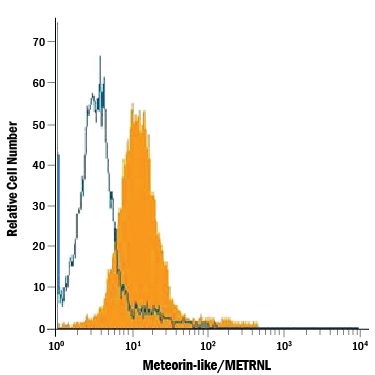Mouse Meteorin-like/METRNL APC-conjugated Antibody Summary
Gln46-Glu311
Accession # Q8VE43
Applications
Please Note: Optimal dilutions should be determined by each laboratory for each application. General Protocols are available in the Technical Information section on our website.
Scientific Data
 View Larger
View Larger
Detection of Meteorin‑like/METRNL in Neuro‑2A Mouse Cell Line by Flow Cytometry. Neuro-2A mouse neuroblastoma cell line was stained with Rat Anti-Mouse Meteorin-like/METRNL APC-conjugated Monoclonal Antibody (Catalog # IC6679A, filled histogram) or isotype control antibody (Catalog # IC013A, open histogram). To facilitate intracellular staining, cells were fixed and permeabilized with FlowX FoxP3 Fixation & Permeabilization Buffer Kit (Catalog # FC012). View our protocol for Staining Intracellular Molecules.
Reconstitution Calculator
Preparation and Storage
- 12 months from date of receipt, 2 to 8 °C as supplied.
Background: Meteorin-like/METRNL
Meteorin-like protein (METRNL) is a 311 amino acid (aa) protein that shows 45% aa homology with Meteorin (in mouse). Meteorin itself is a secreted 30 kDa protein that is expressed in glial and neuronal cells and their precursors during development and in the adult (1‑3). In the adult Meteorin is primarily expressed by astrocytes (3). Meteorin promotes neurite outgrowth, glial cell differentiation, and neuronal survival following excitotoxic injury (2‑5). It also inhibits sprouting angiogenesis and promotes blood vessel maturation (1). Mouse Meteorin‑like protein is synthesized with a 45 amino acid (aa) signal peptide and is selectively expressed in the otic vesicle during inner ear development (6, 7). Mature mouse Meteorin‑like protein shares 79% and 98% aa sequence identity with human and rat Meteorin‑like protein, respectively. Alternate splicing generates an additional isoform that lacks the N‑terminal 82 amino acids including the signal peptide. R&D Systems in‑house testing indicates that Meteorin‑like protein enhances the outgrowth of neurites from cultured mouse cortical neurons. The promoter region of the METRNL gene contains a recognition site for the Pax2, Pax5, and Pax8 transcription factors, and Pax2 binds specifically to this region (7). METRNL is the only gene found within the terminus of the human chromosome 17 q‑arm which can be deleted in the rare Ring 17 syndrome (8).
- Park, J.A. et al. (2008) Glia 56:247.
- Jorgensen, J.R. et al. (2009) J. Mol. Neurosci. 39:104.
- Lee, H.S. et al. (2010) J. Cell Sci. 123:1959.
- Nishino, J. et al. (2004) EMBO J. 23:1998.
- Jorgensen, J.R. et al. (2011) Neurobiol. Dis. 41:160.
- Accession # Q8VE43.
- Ramialison, M. et al. (2008) Genome Biol. 9:R145.
- Surace, C. et al. (2009) Clin. Genet. 76:256.
Product Datasheets
FAQs
No product specific FAQs exist for this product, however you may
View all Antibody FAQsReviews for Mouse Meteorin-like/METRNL APC-conjugated Antibody
There are currently no reviews for this product. Be the first to review Mouse Meteorin-like/METRNL APC-conjugated Antibody and earn rewards!
Have you used Mouse Meteorin-like/METRNL APC-conjugated Antibody?
Submit a review and receive an Amazon gift card.
$25/€18/£15/$25CAN/¥75 Yuan/¥2500 Yen for a review with an image
$10/€7/£6/$10 CAD/¥70 Yuan/¥1110 Yen for a review without an image

